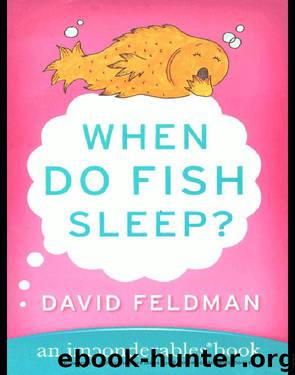When Do Fish Sleep? by David Feldman

Author:David Feldman
Language: eng
Format: mobi, epub
Publisher: HarperCollins
Published: 2012-01-28T02:03:06+00:00
Why Do Recipes Warn Us Not to Use Fresh Pineapple or Kiwifruit in Gelatin? Why Can We Use Canned Pineapple in Gelatin?
Both pineapple and kiwifruit contain enzymes that literally break down gelatin into a pool of glop. The enzyme in pineapple, papain, is also found in papaya and many other tropical fruits. According to the president of the California Kiwifruit Commission, Mark Houston, kiwifruit contains a related enzyme, actinidin, that similarly breaks down gelatin, preventing jelling.
Papain is a particularly important enzyme that has more functions than turning your Jell-O mold into a Jell-O pool. Papain is the active ingredient in meat tenderizers. Just as papain splits the protein in gelatin, it also attacks proteins in meat. Ever experience a stinging sensation in your mouth while eating a fresh pineapple? Papain is attacking your throat.
How can we contain this rapacious enzyme? Just as Kryptonite incapacitates Superman or garlic renders Dracula useless, so heat is the enemy of protein-splitting enzymes such as papain or actinidin. Canned pineapple can be used effectively in gelatin because the heat necessary to the process of canning fruit inactivates the enzymes. Canned pineapple might not taste as good as fresh, but it is much easier on the throat.
Submitted by Marsha Beilsmith of St. Charles, Missouri. Thanks also to David Freling of Hayward, California; and Susan Stock of Marlboro, Massachusetts.
Download
This site does not store any files on its server. We only index and link to content provided by other sites. Please contact the content providers to delete copyright contents if any and email us, we'll remove relevant links or contents immediately.
| Coloring Books for Grown-Ups | Humor |
| Movies | Performing Arts |
| Pop Culture | Puzzles & Games |
| Radio | Sheet Music & Scores |
| Television | Trivia & Fun Facts |
The Infinite Retina by Robert Scoble Irena Cronin(6171)
Harry Potter and the Cursed Child: The Journey by Harry Potter Theatrical Productions(4440)
The Sports Rules Book by Human Kinetics(4294)
Molly's Game: From Hollywood's Elite to Wall Street's Billionaire Boys Club, My High-Stakes Adventure in the World of Underground Poker by Molly Bloom(3486)
A Knight of the Seven Kingdoms by George R R Martin(3191)
Quidditch Through the Ages by J.K. Rowling(3065)
How To by Randall Munroe(3035)
Flowers For Algernon by Daniel Keyes(3021)
Quidditch Through the Ages by J K Rowling & Kennilworthy Whisp(2930)
Quidditch Through the Ages by Kennilworthy Whisp by J.K. Rowling(2816)
Stacked Decks by The Rotenberg Collection(2812)
Quidditch through the Ages by J. K. Rowling(2769)
Quidditch Through The Ages by J. K. Rowling(2730)
776 Stupidest Things Ever Said by Ross Petras(2695)
Ready Player One: A Novel by Ernest Cline(2652)
What If?: Serious Scientific Answers to Absurd Hypothetical Questions by Randall Munroe(2637)
Beautiful Oblivion by Jamie McGuire(2569)
The Book of Questions: Revised and Updated by Gregory Stock Ph.d(2518)
Champions of Illusion by Susana Martinez-Conde & Stephen Macknik(2414)
